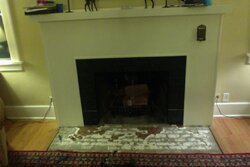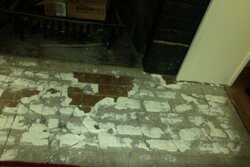- Oct 25, 2012
- 7
We have an older (1917) masonry fireplace that had a ceramic tile hearth extension that was flush with our hardwood floors. The hearth extension had a few large cracks, some of the tiles were missing, and we want to install a wood-burning insert.
So now we're in the process of removing the tiles (slowly) an have found that the cement pad underlying the hearth extension has many more cracks in it. I'm assuming that our house is not going to settle much so we shouldn't see any new crack formation, but I'm wondering whether I need to fix this concrete base before we put down new tile and install the insert? If we do need to fix it I'm hoping for some advice about how. I would prefer not to rip out the entire concrete pad (because it's too much work), but I'd also like for our new tiles to be flush with the hardwood again (so any repair, and mortar to put the tiles in place would have to be quite thin).
I'm grateful for any advice.
With thanks,
John
So now we're in the process of removing the tiles (slowly) an have found that the cement pad underlying the hearth extension has many more cracks in it. I'm assuming that our house is not going to settle much so we shouldn't see any new crack formation, but I'm wondering whether I need to fix this concrete base before we put down new tile and install the insert? If we do need to fix it I'm hoping for some advice about how. I would prefer not to rip out the entire concrete pad (because it's too much work), but I'd also like for our new tiles to be flush with the hardwood again (so any repair, and mortar to put the tiles in place would have to be quite thin).
I'm grateful for any advice.
With thanks,
John



